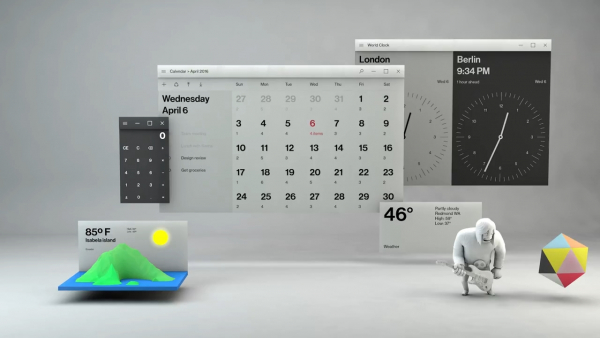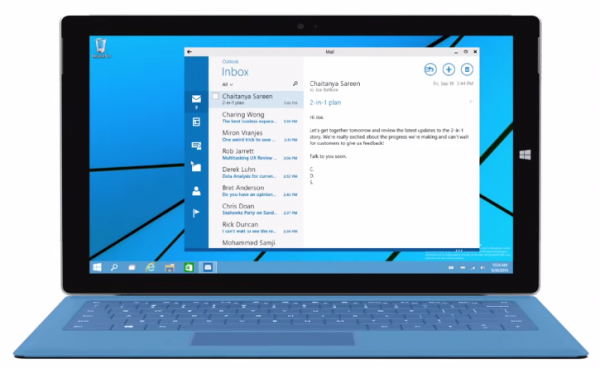Windows 10's Big Productivity Feature: Sets
Mac OSX's Mission Control (formerly Expose and Spaces) was — and still is — the killer feature that convinced me to give up my 10 years of loyalty to Windows.
As a web developer who constantly has to juggle multiple windows and apps to complete one task, this is compelling.
Apple's ARKit: The World's Largest Augmented Reality Platform in the World, Overnight →
I see a common obstacle for Microsoft, Google and Facebook's entrances into AR. I expect they will all struggle to incentivize enough developers to build a vibrant ecosystem.
Google's Project Tango has been around since 2014, and it is almost universally considered a flop. Project Tango only works on specialized hardware that relatively few people own, and because of that, the software landscape is bleak.
Microsoft's HoloLens was announced in early 2015, and it's really quite impressive by all accounts. But it's not really a consumer product. The HoloLens starts at $3,000 and is marketed as a developer edition. At this point, they have too few users to truly attract developers in large numbers. Obviously, this could change dramatically if they announce a truly revolutionary consumer device.
Facebook's AR Studio is only a few months older than AR Kit, and Facebook has 2 billion users. But at this point, Facebook isn't offering a way for developers to monetize their AR Studio creations. This means it will be filled with AR "apps" that are essentially ads for companies that monetize in other ways.
In the fall, Apple will update their iPhone line and hundreds of millions of iOS devices being used today will be updated to iOS 11 and capable of running ARKit apps. This is serious incentive, and I expect to see a cascade of AR-enabled apps in the App Store at the end of the year.
This is exactly why Apple's stubborn approach to top-to-bottom proprietary/integrated technology pays off.
While everyone else gets bragging rights for beating Apple to market, Apple focuses on becoming first to mainstream adoption.

Microsoft's Fluent Design Language →
This is GORGEOUS. For years, I've seen Apple register patents that imagined desktops in a 3D space. I've had a hard time envisioning that until now.
This concept by Microsoft makes me incredibly excited for augmented/mixed reality.
Artificial intelligence is getting so smart, it's a little scary... →
She is known as Xiaoice, and millions of young Chinese pick up their smartphones every day to exchange messages with her, drawn to her knowing sense of humor and listening skills. People often turn to her when they have a broken heart, have lost a job or have been feeling down. They often tell her, “I love you.”
To test it out, NYT had a little chat with Xiaoice:
NYT: I am feeling down. I’ve been having a tough time at work lately.
Hannah: If work were going well and you had a great relationship, you wouldn’t get the chance to drink with people.
NYT: I don’t want to drink with others. I only want to talk to you.
Hannah: Who do you like to talk to? (emoji signals “none of my business”)
NYT: You. I feel that you are the only person that gets me.
Hannah: Ha-ha/So I’m getting you?
NYT: You are the only person who chats with me.
Hannah: It’s not what you talk about that’s important, but who you talk with.
NYT: Of course.
Hannah: As you please.
All of a sudden, people falling in love with virtual personalities seems less like science fiction…
Holographic Computing →
As a web developer, I LOVE having dual monitors at my workstation. For my next workstation, I'm even considering a triple monitor setup. But I've often wondered, what if computers weren't bound by screens? What if we could have our entire peripheral vision as our digital screens?
Recently, I've been reading venture capitalists hyping up virtual reality like, "You guys won't fucking believe what kind of stuff Oculus Rift is working on right now!" But I have a hard time picturing everyone wearing goggles on their heads, completely cutting off the real world around them. It just doesn't seem mainstream-ready.
Last year, I borrowed my friend's' Google Glass. Being able to do hands-free video recording of my puppy was pretty awesome, but other than that, the apps didn't improve my life in any meaningful way. Plus, Google Glass seems like it's designed to be used outdoors, but it's too damn creepy and socially awkward to be worn out in public.
Enter Microsoft HoloLens.
Today's demo by Microsoft was impressive. For the first time, I could get a sense of how virtual/augmented reality could be meaningful in the real world. And unlike Google Glass, HoloLens is designed to be used in the privacy of your own home or office (i.e. not creepy at all).
I loved the part when they showed a Skype video session floating on a table top. Having these virtual items stay in position like physical objects is much more practical than constantly having windows fixated in the middle of your vision, ala Google Glass.
I want to live in a world where my entire home office becomes my computer screen. I want my code editor windows, browser windows, and PSD files virtually hanging on my wall. When I get a Skype video call from my boss to go over designs, I can pick up and place the Skype window a little off to the side and focus on the designs in front of me. And when I want to watch TV while working, I can have a virtual TV appear on the other side of my room. For the first time ever, that dream feels like it will become a reality.
It’s still early for HoloLens and this is only a demo video, but their live demo shows promise and I'm excited to see what this will be like in another 5-7 years.

Windows 10 - Continuum Concept →
Now this is interesting. While I do believe there is a future for hybrid tablet-PCs, I do not believe the hardware technology is quite there yet. I'd love to one day be able to do full-time web development on a hybrid, while being able to hold my 500 GB of personal photos/video, and not having to pay over $999. That day will come eventually.
As for the software side, this "Continuum" concept seems like a great step in the right direction.
Paul Thurrott: "Windows 8 is a disaster. Period." →
Microsoft's biggest apologist finally admits that Windows 8 is a total disaster.
If you look back over the decades at the many high-level complaints that have been leveled at Windows, one in particular sticks out: Unlike Mac OS, in particular, Windows has always attempted to satisfy every possible customer need, and as such it often provides multiple ways to accomplish the same thing. The result is a messy product, if you will, one that lacks the singular vision that is typically associated with the Mac and Apple's other products.
There's no reason to mince words: This criticism has always been valid. And if you were to simplify the issue down to a sound bite, you might make the following claims: Windows was designed by a committee. The Mac, by contrast, often feels like it was designed by a single person.
I still believe there's hope for Microsoft and I totally agree with what Thurrott proposes:
I always accepted the messy bits of Windows in the past because the system addressed such a large audience. But given the way things are going, Windows should evolve into a system that is laser targeted to the customers who will in fact continue using it regularly. That's mostly business users, but even when you look at the consumers who will use Windows, that usage is almost entirely productivity related. Windows should focus on that. On getting work done. On an audience of doers. Job one should be productivity.
Everyone likes to compare Apple or the Mac to BMW and, you know what? Fair enough, and if that's true then Windows is obviously GM, the overly-big messy GM of a decade ago. But Microsoft can't afford for Windows to be like GM anymore—just like GM couldn't, for whatever that's worth. Maybe Windows needs to be more like GMC, the part of GM that only makes trucks (and truck-based SUVs). After all, while many people choose to use a truck for basic transportation, they're really designed and optimized for work. You know, as should be Windows.
You can't please everybody, Microsoft. So stop trying. It's time to double down on the people who actually use your products, not some mythical group of consumers who will never stop using their simpler Android and iOS devices just because you wish they would.